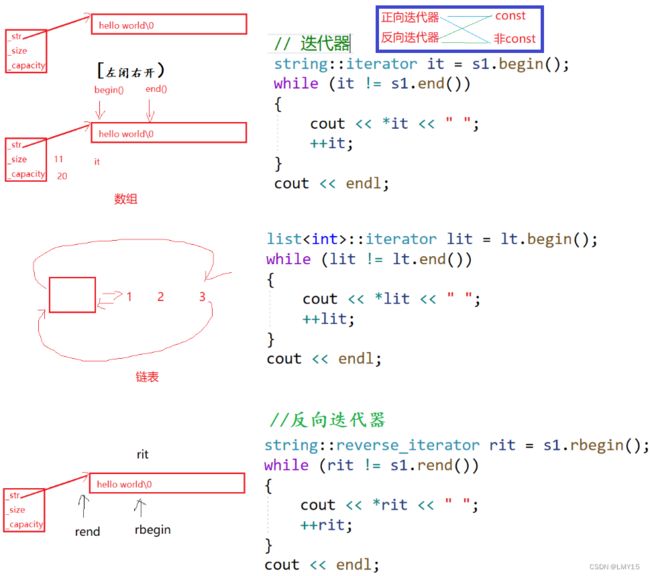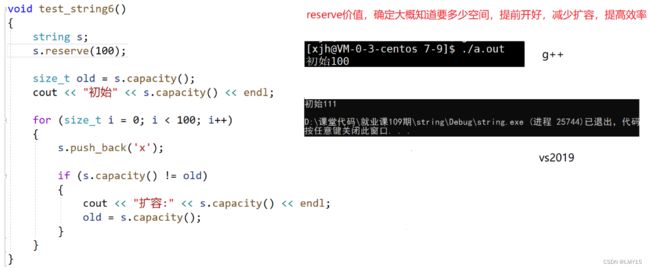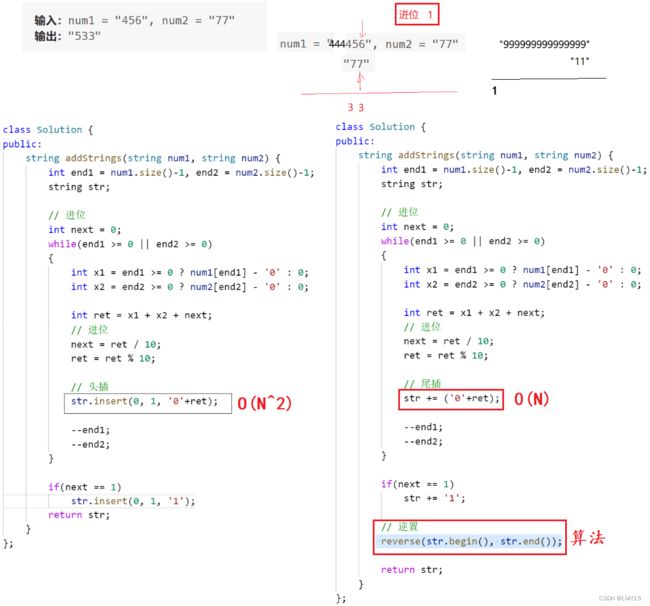1、string的使用
#define _CRT_SECURE_NO_WARNINGS 1
#include
#include
using namespace std;
void Test1()
{
string s1;
string s2("hello");
cin >> s1;
cout << s1 << endl;
string ret1 = s1 + s1;
cout << ret1 << endl;
string ret2 = s1 + "我来了";
cout << ret2 << endl;
}
void Test2()
{
string s1("Hello String");
string s2 = "Hello String";
string s3("Hello String");
for (int i = 0; i < s1.size(); i++)
{
cout << s1[i];
}
cout << endl;
for (int i = 0; i < s1.size(); i++)
{
s1[i]++;
}
cout << s1 << endl;
cout << "------------" << endl;
string::iterator it = s2.begin();
while (it != s2.end())
{
cout << *it;
++it;
}
cout << endl;
it = s2.begin();
while (it != s2.end())
{
*it = 'A';
++it;
}
cout << s2 << endl;
cout << "------------" << endl;
for (auto ch : s3)
{
cout << ch;
}
cout << endl;
for (auto& ch : s3)
{
++ch;
}
cout << s3 << endl;
}
void Test3()
{
string s1("Hello String");
auto rit = s1.rbegin();
while (rit != s1.rend())
{
cout << *rit;
++rit;
}
cout << endl;
}
void func(const string& s)
{
auto it = s.begin();
while (it != s.end())
{
cout << *it;
++it;
}
cout << endl;
auto rit = s.rbegin();
while (rit != s.rend())
{
cout << *rit;
++rit;
}
cout << endl;
}
void Test4()
{
string s1("Hello String");
func(s1);
}
void Test5()
{
string s1("Hello String");
string s2(s1);
string s3(s1, 6, 6);
cout << s3 << endl;
string s4(s2, 6, 3);
cout << s4 << endl;
string s5("Hello String XXXXXXXXXXXXXXXXXXXXXXXXX");
cout << string(s5, 6, s5.size() - 1) << endl;
cout << string(s5, 6) << endl;
string s6(10, 'A');
cout << s6 << endl;
cout << string("Hello String", 5) << endl;
string s8(s1.begin(), s1.end());
cout << s8 << endl;
string s9(++s1.begin(), --s1.end());
cout << s9 << endl;
s9 = s8;
s9 = "XXX";
s9 = 'Y';
}
void Test6()
{
string s1("Hello String");
cout << s1.size() << endl;
cout << s1.length() << endl;
cout << s1.capacity() << endl;
s1.clear();
s1 = "LMY";
cout << s1.capacity() << endl;
}
void Test7()
{
string s;
s.reserve(100);
size_t old = s.capacity();
cout << "初始容量:" << s.capacity() << endl;
for (size_t i = 0; i < 100; i++)
{
s.push_back('x');
if (s.capacity() != old)
{
cout << "扩容成功:" << s.capacity() << endl;
old = s.capacity();
}
}
s.reserve(10);
cout << "缩后空间容量:" << s.capacity() << endl;
}
void Test8()
{
string s("Hello World");
cout << "resize前:" << s.size() << endl;
cout << "resize前:" << s.capacity() << endl << endl;
s.resize(13, 'x');
cout << s << endl;
cout << "resize后:" << s.size() << endl;
cout << "resize后:" << s.capacity() << endl << endl;
s.resize(20, 'x');
cout << s << endl;
cout << "resize后:" << s.size() << endl;
cout << "resize后:" << s.capacity() << endl << endl;
s.resize(5);
cout << s << endl;
cout << "resize后:" << s.size() << endl;
cout << "resize后:" << s.capacity() << endl << endl;
}
void Test9()
{
string s("Hello World");
s.insert(0, 1, 'L');
s.insert(s.begin(), 'L');
cout << s << endl;
s.erase(8,2);
cout << s << endl;
s.erase(5);
cout << s << endl << endl;
string s2("The quick brown fox jumps over a lazy dog.");
string s3;
for (auto ch : s2)
{
if (ch != ' ')
{
s3 += ch;
}
else
{
s3 += "20%";
}
}
printf("s2:%p\n", s2.c_str());
printf("s3:%p\n", s3.c_str());
s2.swap(s3);
cout << s2 << endl;
printf("s2:%p\n", s2.c_str());
printf("s3:%p\n", s3.c_str());
}
void Test10()
{
string s1("test.cpp.tar.zip");
size_t i = s1.find('.');
string s2 = s1.substr(i);
cout << s2 << endl;
size_t j = s1.rfind('.');
string s3 = s1.substr(j);
cout << s3 << endl << endl;
string s("https://cplusplus.com/reference/string/string/");
string sub1, sub2, sub3;
size_t i1 = s.find(':');
if (i1 != string::npos)
sub1 = s.substr(0, i1);
else
cout << "没有找到i1" << endl;
size_t i2 = s.find('/', i1 + 3);
if (i2 != string::npos)
sub2 = s.substr(i1 + 3, i2 - (i1 + 3));
else
cout << "没有找到i2" << endl;
sub3 = s.substr(i2 + 1);
cout << sub1 << endl;
cout << sub2 << endl;
cout << sub3 << endl;
}
void Test11()
{
string str;
getline(cin, str, '!');
cout << str;
}
int main()
{
Test11();
return 0;
}



2、string的OJ题
(1)字符串中的第一个唯一字符
class Solution
{
public:
int firstUniqChar(string s)
{
int count[26] = { 0 };
for (auto ch : s)
{
count[ch - 'a']++;
}
for (int i = 0; i < s.size(); i++)
{
if (count[s[i] - 'a'] == 1)
{
return i;
}
}
return -1;
}
};
(2)仅仅反转字母
class Solution
{
public:
bool IsLater(char ch)
{
if (ch >= 'a' && ch <= 'z')
return true;
if (ch >= 'A' && ch <= 'Z')
return true;
return false;
}
string reverseOnlyLetters(string s)
{
if (s.empty())
return s;
int begin = 0;
int end = s.size() - 1;
while (begin < end)
{
while (begin < end && !IsLater(s[begin]))
{
begin++;
}
while (begin < end && !IsLater(s[end]))
{
end--;
}
swap(s[begin], s[end]);
begin++;
end--;
}
return s;
}
};
(3)字符串最后一个单词的长度
- scanf / cin 遇到空格和换行符自动停止读取,空格和换行符后边的内容会被放在缓冲区中不被此次读取。但是 getline 可以。
getline(cin, s);【可以读取一整行,遇到空格不停,遇到换行符才停止读取内容】getline(cin, str, '!'); 【读取到’!'结束】
#include
#include
using namespace std;
int main()
{
string s;
getline(cin, s);
size_t i = s.rfind(' ');
if (i != string::npos)
{
cout << s.size() - (i + 1) << endl;
}
else
{
cout << s.size() << endl;
}
return 0;
}
(4)字符串相加
class Solution
{
public:
string addStrings(string num1, string num2)
{
string str;
int next = 0;
int end1 = num1.size() - 1;
int end2 = num2.size() - 1;
while (end1 >= 0 || end2 >= 0)
{
int x1 = end1 >= 0 ? num1[end1] - '0' : 0;
int x2 = end2 >= 0 ? num2[end2] - '0' : 0;
int ret = x1 + x2 + next;
next = ret / 10;
ret = ret % 10;
str += ret + '0';
end1--;
end2--;
}
if (next == 1)
{
str += next + '0';
}
reverse(str.begin(), str.end());
return str;
}
};

(5)验证回文串
class Solution
{
public:
bool IsLatter(char ch)
{
return (ch >= 'A' && ch <= 'Z') || (ch >= 'a' && ch <= 'z') || (ch >= '0' && ch <= '9');
}
bool isPalindrome(string s)
{
for (auto& ch : s)
{
if (ch >= 'A' && ch <= 'Z')
{
ch += 32;
}
}
int begin = 0;
int end = s.size() - 1;
while (begin < end)
{
while (begin < end && !IsLatter(s[begin]))
{
begin++;
}
while (begin < end && !IsLatter(s[end]))
{
end--;
}
if (s[begin] == s[end])
{
begin++;
end--;
}
else
{
return false;
}
}
return true;
}
};
(6)字符串转整型数字
class Solution
{
public:
int StrToInt(string str)
{
int len = str.size();
int flag = 1;
int sum = 0;
if (str[0] == '-')
{
flag = -1;
}
for (int i = len - 1; i >= 0; i--)
{
if (str[i] == '+' || str[i] == '-')
{
continue;
}
if (str[i] >= '0' && str[i] <= '9')
{
int n = 1;
for (int j = len - 1; j > i; j--)
{
n = n * 10;
}
sum += (str[i] - '0') * n;
}
else
{
return 0;
}
}
return flag * sum;
}
};
(7)反转字符串Ⅰ
class Solution
{
public:
void reverseString(vector<char>& s)
{
int begin = 0;
int end = s.size() - 1;
while (begin < end)
{
swap(s[begin], s[end]);
begin++;
end--;
}
}
};
(8)反转字符串Ⅱ
class Solution
{
public:
void Reverse(string& s, int start, int end)
{
while (start < end)
{
swap(s[start], s[end]);
start++;
end--;
}
}
string reverseStr(string s, int k)
{
int len = s.size();
for (int i = 0; i < len; i += 2 * k)
{
if (i + k < len)
Reverse(s, i, i + k - 1);
else
Reverse(s, i, len - 1);
}
return s;
}
};
(9)反转字符串中的单词
class Solution
{
public:
void reverse(string& s, int begin, int end)
{
while (begin < end)
{
swap(s[begin], s[end]);
begin++;
end--;
}
}
string reverseWords(string s)
{
int begin = 0;
int end = 0;
while (end < s.size())
{
end = s.find(' ', begin);
if (end == string::npos)
{
end = s.size();
break;
}
reverse(s, begin, end - 1);
begin = end + 1;
}
reverse(s, begin, end - 1);
return s;
}
};
(10)字符串相乘
- 两个数相乘之后的结果的位数肯定不会超过两个数位数之和,定义一个长度为两数位数之和的字符串,然后从尾部开始迭代,通过取余和整除的操作依次计算各位结果,最后通过 substr 从不为零的位置返回字符串。
class Solution
{
public:
string multiply(string num1, string num2)
{
int len1 = num1.size();
int len2 = num2.size();
string arr(len1 + len2, '0');
for (int i = len1 - 1; i >= 0; i--)
{
for (int j = len2 - 1; j >= 0; j--)
{
int tmp = (num1[i] - '0') * (num2[j] - '0') + (arr[i + j + 1] - '0');
arr[i + j + 1] = tmp % 10 + '0';
arr[i + j] = tmp / 10 + (arr[i + j] - '0') + '0';
}
}
for (int i = 0; i < len1 + len2; i++)
{
if (arr[i] != '0')
{
return arr.substr(i);
}
}
return "0";
}
};



